Triple Bottom Line of Sustainability: Patagonia Case Study Report
VerifiedAdded on 2023/04/04
|23
|5272
|126
Report
AI Summary
This report examines the concept of sustainable supply chain management through the lens of the triple bottom line approach and a case study of Patagonia. It begins with an executive summary and an introduction setting the context of sustainability in business, supported by secondary data. A literature review explores key concepts such as supply chain management, sustainability, the triple bottom line, and green supply chain logistics, along with the challenges businesses face in implementing sustainable practices. The core of the report analyzes Patagonia's sustainability efforts within its supply chain, evaluating its practices against the theoretical framework. The report concludes with recommendations for Patagonia, including time-based competition, a triple bottom line approach, and a "recycle and reuse policy", and also offers general recommendations for the fashion industry based on the research and analysis conducted. The report is structured with references and appendices using RMIT Harvard style.
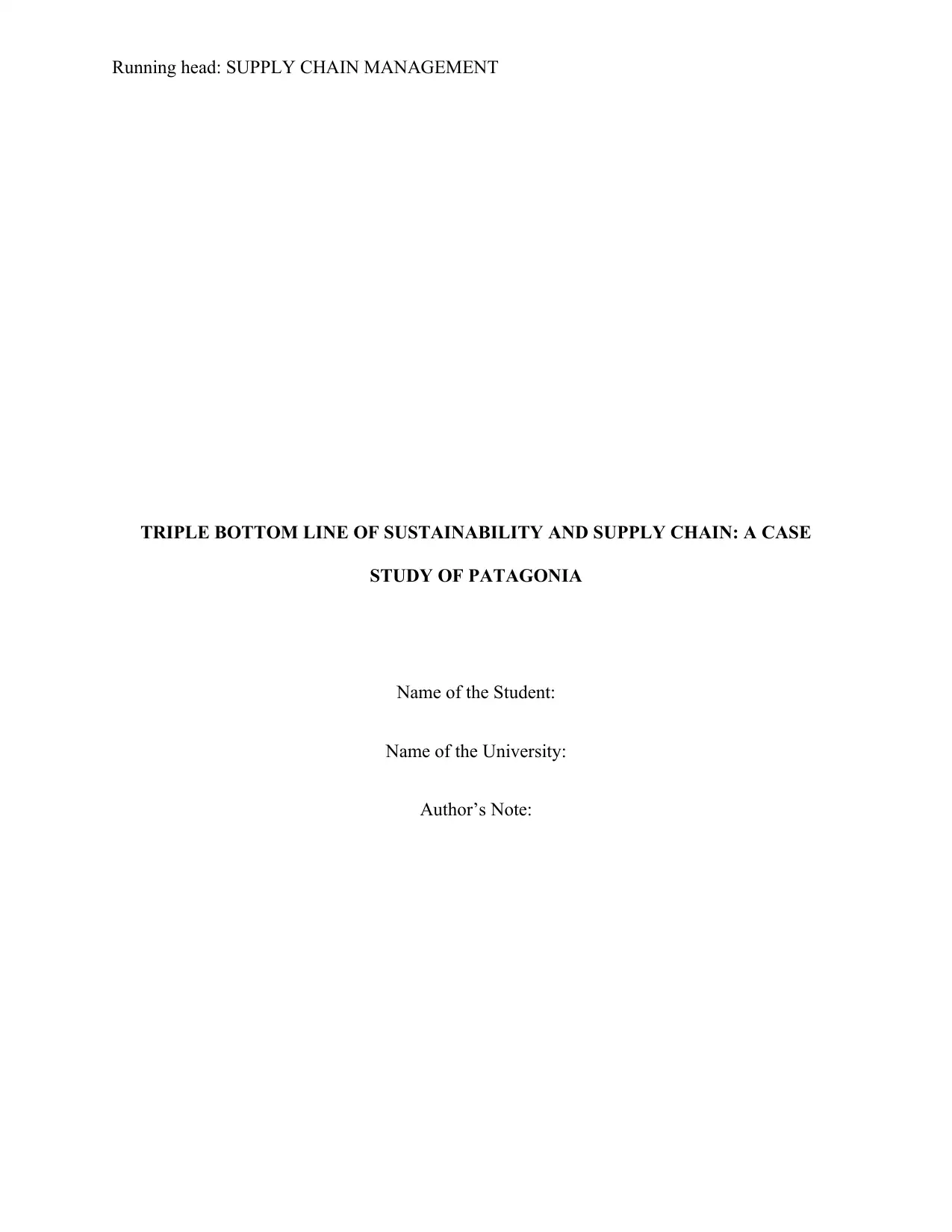
Running head: SUPPLY CHAIN MANAGEMENT
TRIPLE BOTTOM LINE OF SUSTAINABILITY AND SUPPLY CHAIN: A CASE
STUDY OF PATAGONIA
Name of the Student:
Name of the University:
Author’s Note:
TRIPLE BOTTOM LINE OF SUSTAINABILITY AND SUPPLY CHAIN: A CASE
STUDY OF PATAGONIA
Name of the Student:
Name of the University:
Author’s Note:
Paraphrase This Document
Need a fresh take? Get an instant paraphrase of this document with our AI Paraphraser
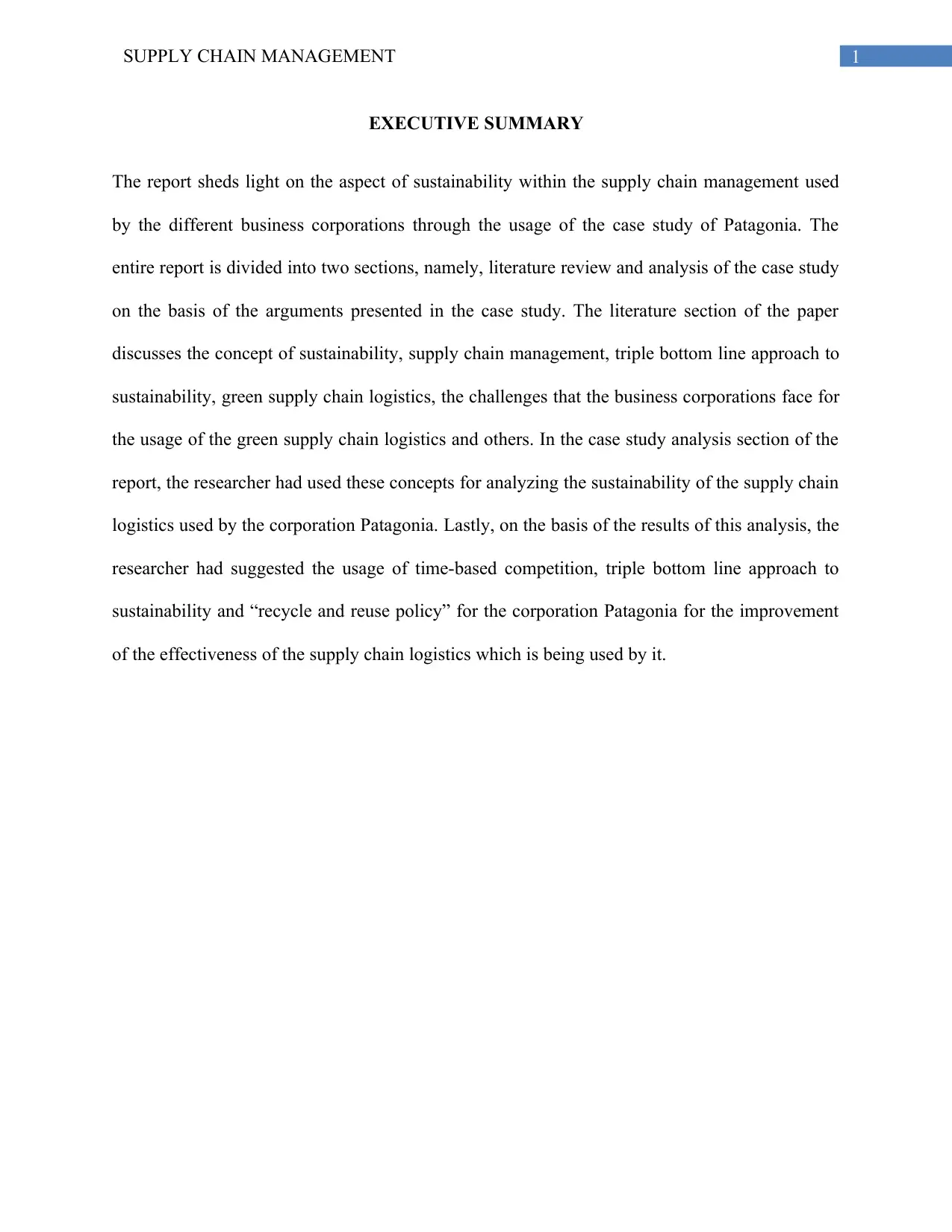
1SUPPLY CHAIN MANAGEMENT
EXECUTIVE SUMMARY
The report sheds light on the aspect of sustainability within the supply chain management used
by the different business corporations through the usage of the case study of Patagonia. The
entire report is divided into two sections, namely, literature review and analysis of the case study
on the basis of the arguments presented in the case study. The literature section of the paper
discusses the concept of sustainability, supply chain management, triple bottom line approach to
sustainability, green supply chain logistics, the challenges that the business corporations face for
the usage of the green supply chain logistics and others. In the case study analysis section of the
report, the researcher had used these concepts for analyzing the sustainability of the supply chain
logistics used by the corporation Patagonia. Lastly, on the basis of the results of this analysis, the
researcher had suggested the usage of time-based competition, triple bottom line approach to
sustainability and “recycle and reuse policy” for the corporation Patagonia for the improvement
of the effectiveness of the supply chain logistics which is being used by it.
EXECUTIVE SUMMARY
The report sheds light on the aspect of sustainability within the supply chain management used
by the different business corporations through the usage of the case study of Patagonia. The
entire report is divided into two sections, namely, literature review and analysis of the case study
on the basis of the arguments presented in the case study. The literature section of the paper
discusses the concept of sustainability, supply chain management, triple bottom line approach to
sustainability, green supply chain logistics, the challenges that the business corporations face for
the usage of the green supply chain logistics and others. In the case study analysis section of the
report, the researcher had used these concepts for analyzing the sustainability of the supply chain
logistics used by the corporation Patagonia. Lastly, on the basis of the results of this analysis, the
researcher had suggested the usage of time-based competition, triple bottom line approach to
sustainability and “recycle and reuse policy” for the corporation Patagonia for the improvement
of the effectiveness of the supply chain logistics which is being used by it.
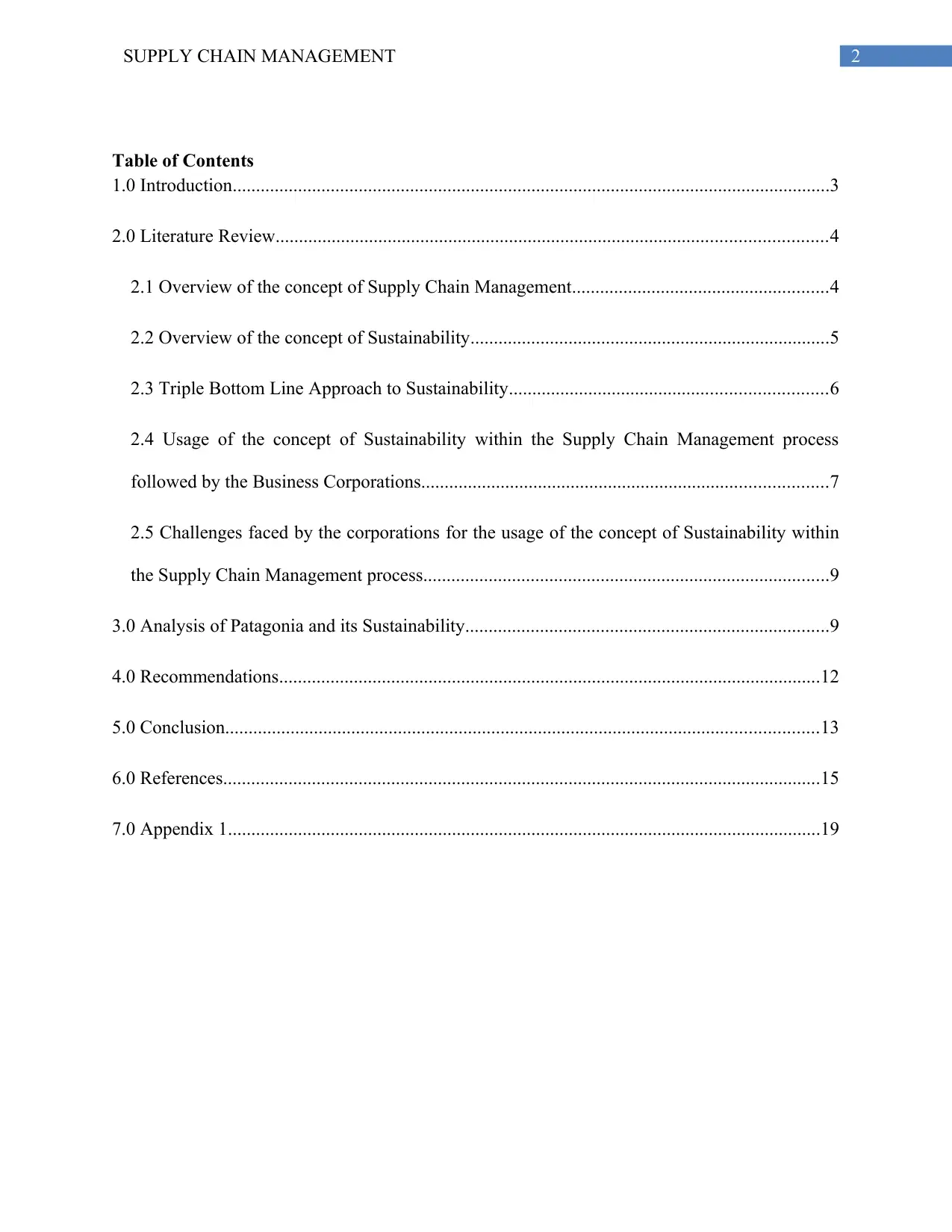
2SUPPLY CHAIN MANAGEMENT
Table of Contents
1.0 Introduction................................................................................................................................3
2.0 Literature Review......................................................................................................................4
2.1 Overview of the concept of Supply Chain Management.......................................................4
2.2 Overview of the concept of Sustainability.............................................................................5
2.3 Triple Bottom Line Approach to Sustainability....................................................................6
2.4 Usage of the concept of Sustainability within the Supply Chain Management process
followed by the Business Corporations.......................................................................................7
2.5 Challenges faced by the corporations for the usage of the concept of Sustainability within
the Supply Chain Management process.......................................................................................9
3.0 Analysis of Patagonia and its Sustainability..............................................................................9
4.0 Recommendations....................................................................................................................12
5.0 Conclusion...............................................................................................................................13
6.0 References................................................................................................................................15
7.0 Appendix 1...............................................................................................................................19
Table of Contents
1.0 Introduction................................................................................................................................3
2.0 Literature Review......................................................................................................................4
2.1 Overview of the concept of Supply Chain Management.......................................................4
2.2 Overview of the concept of Sustainability.............................................................................5
2.3 Triple Bottom Line Approach to Sustainability....................................................................6
2.4 Usage of the concept of Sustainability within the Supply Chain Management process
followed by the Business Corporations.......................................................................................7
2.5 Challenges faced by the corporations for the usage of the concept of Sustainability within
the Supply Chain Management process.......................................................................................9
3.0 Analysis of Patagonia and its Sustainability..............................................................................9
4.0 Recommendations....................................................................................................................12
5.0 Conclusion...............................................................................................................................13
6.0 References................................................................................................................................15
7.0 Appendix 1...............................................................................................................................19
⊘ This is a preview!⊘
Do you want full access?
Subscribe today to unlock all pages.

Trusted by 1+ million students worldwide
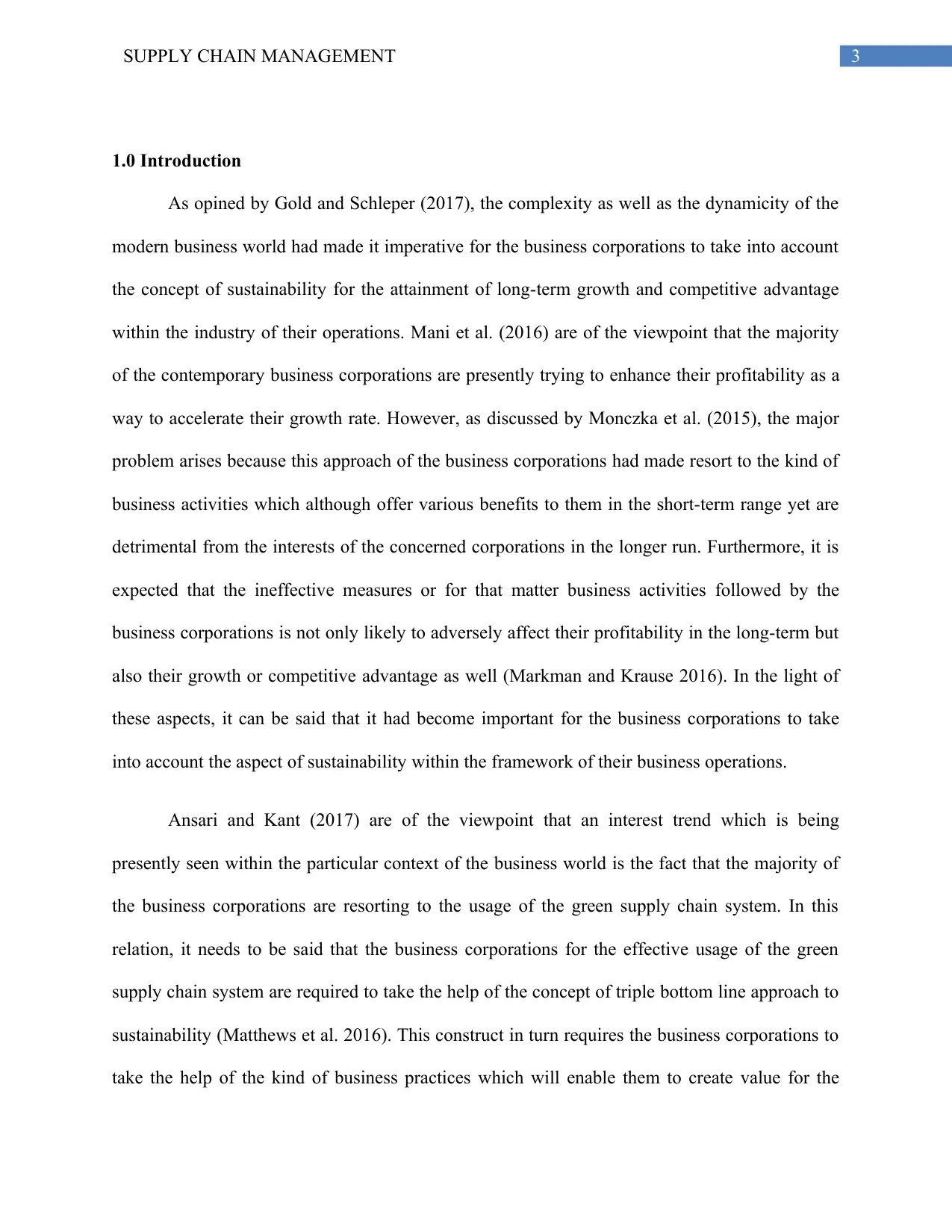
3SUPPLY CHAIN MANAGEMENT
1.0 Introduction
As opined by Gold and Schleper (2017), the complexity as well as the dynamicity of the
modern business world had made it imperative for the business corporations to take into account
the concept of sustainability for the attainment of long-term growth and competitive advantage
within the industry of their operations. Mani et al. (2016) are of the viewpoint that the majority
of the contemporary business corporations are presently trying to enhance their profitability as a
way to accelerate their growth rate. However, as discussed by Monczka et al. (2015), the major
problem arises because this approach of the business corporations had made resort to the kind of
business activities which although offer various benefits to them in the short-term range yet are
detrimental from the interests of the concerned corporations in the longer run. Furthermore, it is
expected that the ineffective measures or for that matter business activities followed by the
business corporations is not only likely to adversely affect their profitability in the long-term but
also their growth or competitive advantage as well (Markman and Krause 2016). In the light of
these aspects, it can be said that it had become important for the business corporations to take
into account the aspect of sustainability within the framework of their business operations.
Ansari and Kant (2017) are of the viewpoint that an interest trend which is being
presently seen within the particular context of the business world is the fact that the majority of
the business corporations are resorting to the usage of the green supply chain system. In this
relation, it needs to be said that the business corporations for the effective usage of the green
supply chain system are required to take the help of the concept of triple bottom line approach to
sustainability (Matthews et al. 2016). This construct in turn requires the business corporations to
take the help of the kind of business practices which will enable them to create value for the
1.0 Introduction
As opined by Gold and Schleper (2017), the complexity as well as the dynamicity of the
modern business world had made it imperative for the business corporations to take into account
the concept of sustainability for the attainment of long-term growth and competitive advantage
within the industry of their operations. Mani et al. (2016) are of the viewpoint that the majority
of the contemporary business corporations are presently trying to enhance their profitability as a
way to accelerate their growth rate. However, as discussed by Monczka et al. (2015), the major
problem arises because this approach of the business corporations had made resort to the kind of
business activities which although offer various benefits to them in the short-term range yet are
detrimental from the interests of the concerned corporations in the longer run. Furthermore, it is
expected that the ineffective measures or for that matter business activities followed by the
business corporations is not only likely to adversely affect their profitability in the long-term but
also their growth or competitive advantage as well (Markman and Krause 2016). In the light of
these aspects, it can be said that it had become important for the business corporations to take
into account the aspect of sustainability within the framework of their business operations.
Ansari and Kant (2017) are of the viewpoint that an interest trend which is being
presently seen within the particular context of the business world is the fact that the majority of
the business corporations are resorting to the usage of the green supply chain system. In this
relation, it needs to be said that the business corporations for the effective usage of the green
supply chain system are required to take the help of the concept of triple bottom line approach to
sustainability (Matthews et al. 2016). This construct in turn requires the business corporations to
take the help of the kind of business practices which will enable them to create value for the
Paraphrase This Document
Need a fresh take? Get an instant paraphrase of this document with our AI Paraphraser
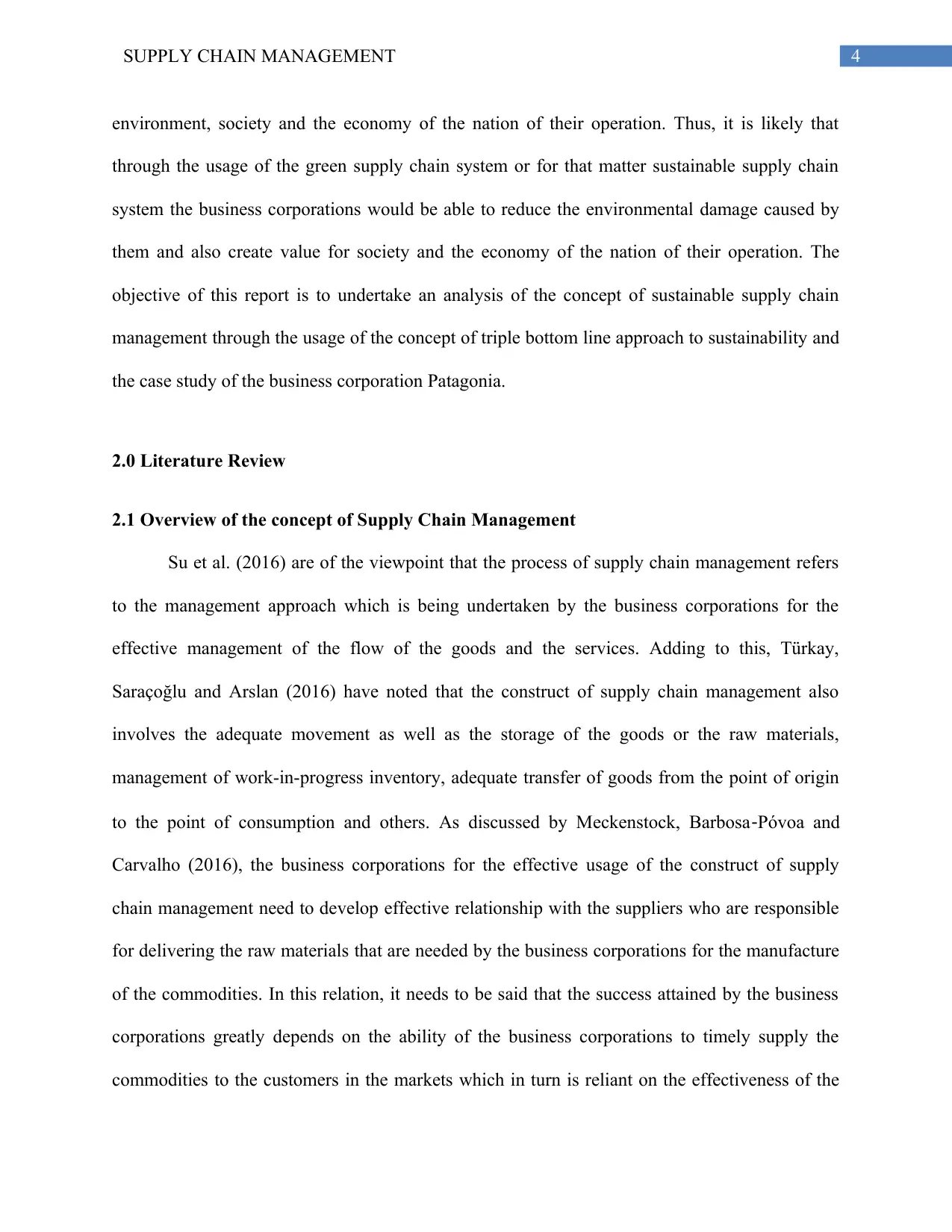
4SUPPLY CHAIN MANAGEMENT
environment, society and the economy of the nation of their operation. Thus, it is likely that
through the usage of the green supply chain system or for that matter sustainable supply chain
system the business corporations would be able to reduce the environmental damage caused by
them and also create value for society and the economy of the nation of their operation. The
objective of this report is to undertake an analysis of the concept of sustainable supply chain
management through the usage of the concept of triple bottom line approach to sustainability and
the case study of the business corporation Patagonia.
2.0 Literature Review
2.1 Overview of the concept of Supply Chain Management
Su et al. (2016) are of the viewpoint that the process of supply chain management refers
to the management approach which is being undertaken by the business corporations for the
effective management of the flow of the goods and the services. Adding to this, Türkay,
Saraçoğlu and Arslan (2016) have noted that the construct of supply chain management also
involves the adequate movement as well as the storage of the goods or the raw materials,
management of work-in-progress inventory, adequate transfer of goods from the point of origin
to the point of consumption and others. As discussed by Meckenstock, Barbosa‐Póvoa and
Carvalho (2016), the business corporations for the effective usage of the construct of supply
chain management need to develop effective relationship with the suppliers who are responsible
for delivering the raw materials that are needed by the business corporations for the manufacture
of the commodities. In this relation, it needs to be said that the success attained by the business
corporations greatly depends on the ability of the business corporations to timely supply the
commodities to the customers in the markets which in turn is reliant on the effectiveness of the
environment, society and the economy of the nation of their operation. Thus, it is likely that
through the usage of the green supply chain system or for that matter sustainable supply chain
system the business corporations would be able to reduce the environmental damage caused by
them and also create value for society and the economy of the nation of their operation. The
objective of this report is to undertake an analysis of the concept of sustainable supply chain
management through the usage of the concept of triple bottom line approach to sustainability and
the case study of the business corporation Patagonia.
2.0 Literature Review
2.1 Overview of the concept of Supply Chain Management
Su et al. (2016) are of the viewpoint that the process of supply chain management refers
to the management approach which is being undertaken by the business corporations for the
effective management of the flow of the goods and the services. Adding to this, Türkay,
Saraçoğlu and Arslan (2016) have noted that the construct of supply chain management also
involves the adequate movement as well as the storage of the goods or the raw materials,
management of work-in-progress inventory, adequate transfer of goods from the point of origin
to the point of consumption and others. As discussed by Meckenstock, Barbosa‐Póvoa and
Carvalho (2016), the business corporations for the effective usage of the construct of supply
chain management need to develop effective relationship with the suppliers who are responsible
for delivering the raw materials that are needed by the business corporations for the manufacture
of the commodities. In this relation, it needs to be said that the success attained by the business
corporations greatly depends on the ability of the business corporations to timely supply the
commodities to the customers in the markets which in turn is reliant on the effectiveness of the
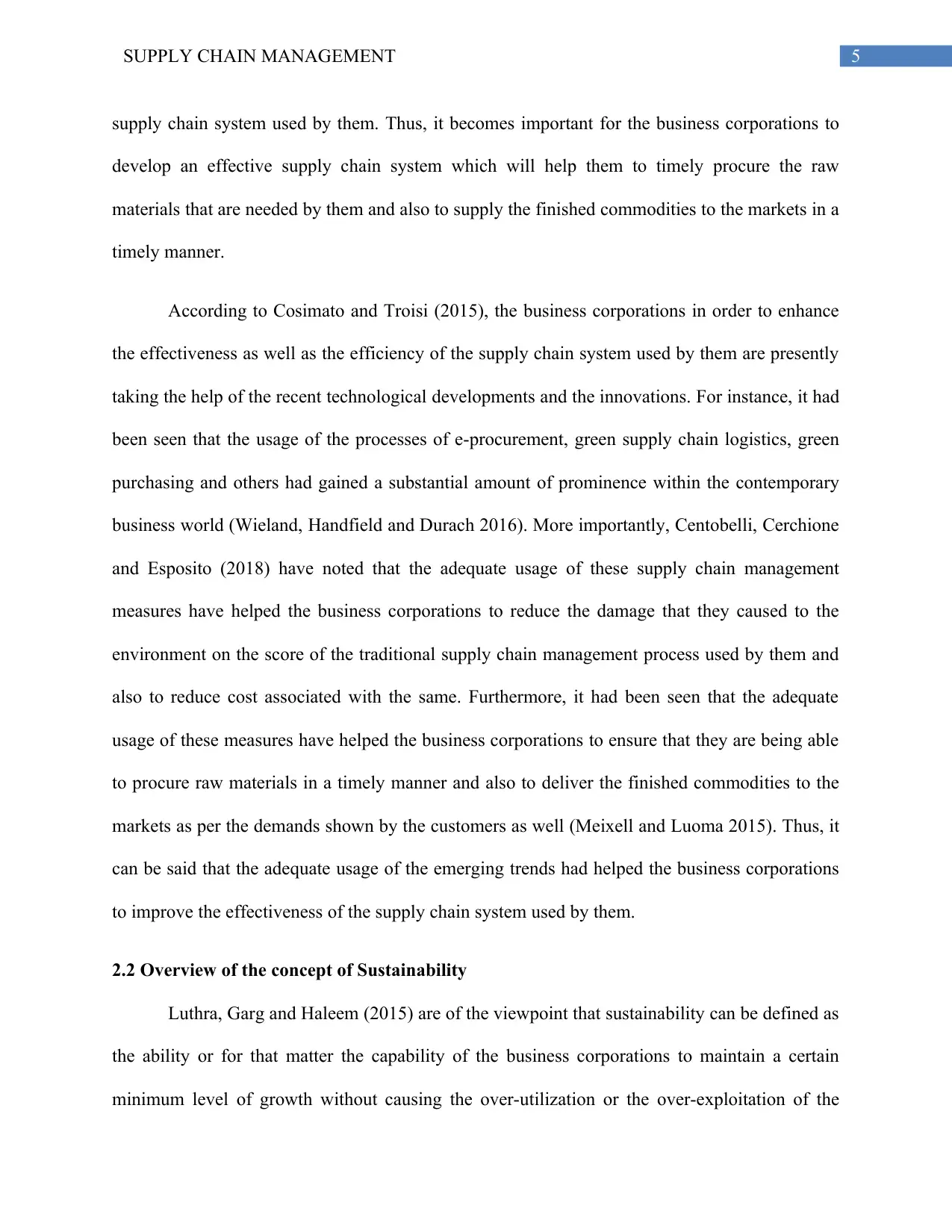
5SUPPLY CHAIN MANAGEMENT
supply chain system used by them. Thus, it becomes important for the business corporations to
develop an effective supply chain system which will help them to timely procure the raw
materials that are needed by them and also to supply the finished commodities to the markets in a
timely manner.
According to Cosimato and Troisi (2015), the business corporations in order to enhance
the effectiveness as well as the efficiency of the supply chain system used by them are presently
taking the help of the recent technological developments and the innovations. For instance, it had
been seen that the usage of the processes of e-procurement, green supply chain logistics, green
purchasing and others had gained a substantial amount of prominence within the contemporary
business world (Wieland, Handfield and Durach 2016). More importantly, Centobelli, Cerchione
and Esposito (2018) have noted that the adequate usage of these supply chain management
measures have helped the business corporations to reduce the damage that they caused to the
environment on the score of the traditional supply chain management process used by them and
also to reduce cost associated with the same. Furthermore, it had been seen that the adequate
usage of these measures have helped the business corporations to ensure that they are being able
to procure raw materials in a timely manner and also to deliver the finished commodities to the
markets as per the demands shown by the customers as well (Meixell and Luoma 2015). Thus, it
can be said that the adequate usage of the emerging trends had helped the business corporations
to improve the effectiveness of the supply chain system used by them.
2.2 Overview of the concept of Sustainability
Luthra, Garg and Haleem (2015) are of the viewpoint that sustainability can be defined as
the ability or for that matter the capability of the business corporations to maintain a certain
minimum level of growth without causing the over-utilization or the over-exploitation of the
supply chain system used by them. Thus, it becomes important for the business corporations to
develop an effective supply chain system which will help them to timely procure the raw
materials that are needed by them and also to supply the finished commodities to the markets in a
timely manner.
According to Cosimato and Troisi (2015), the business corporations in order to enhance
the effectiveness as well as the efficiency of the supply chain system used by them are presently
taking the help of the recent technological developments and the innovations. For instance, it had
been seen that the usage of the processes of e-procurement, green supply chain logistics, green
purchasing and others had gained a substantial amount of prominence within the contemporary
business world (Wieland, Handfield and Durach 2016). More importantly, Centobelli, Cerchione
and Esposito (2018) have noted that the adequate usage of these supply chain management
measures have helped the business corporations to reduce the damage that they caused to the
environment on the score of the traditional supply chain management process used by them and
also to reduce cost associated with the same. Furthermore, it had been seen that the adequate
usage of these measures have helped the business corporations to ensure that they are being able
to procure raw materials in a timely manner and also to deliver the finished commodities to the
markets as per the demands shown by the customers as well (Meixell and Luoma 2015). Thus, it
can be said that the adequate usage of the emerging trends had helped the business corporations
to improve the effectiveness of the supply chain system used by them.
2.2 Overview of the concept of Sustainability
Luthra, Garg and Haleem (2015) are of the viewpoint that sustainability can be defined as
the ability or for that matter the capability of the business corporations to maintain a certain
minimum level of growth without causing the over-utilization or the over-exploitation of the
⊘ This is a preview!⊘
Do you want full access?
Subscribe today to unlock all pages.

Trusted by 1+ million students worldwide
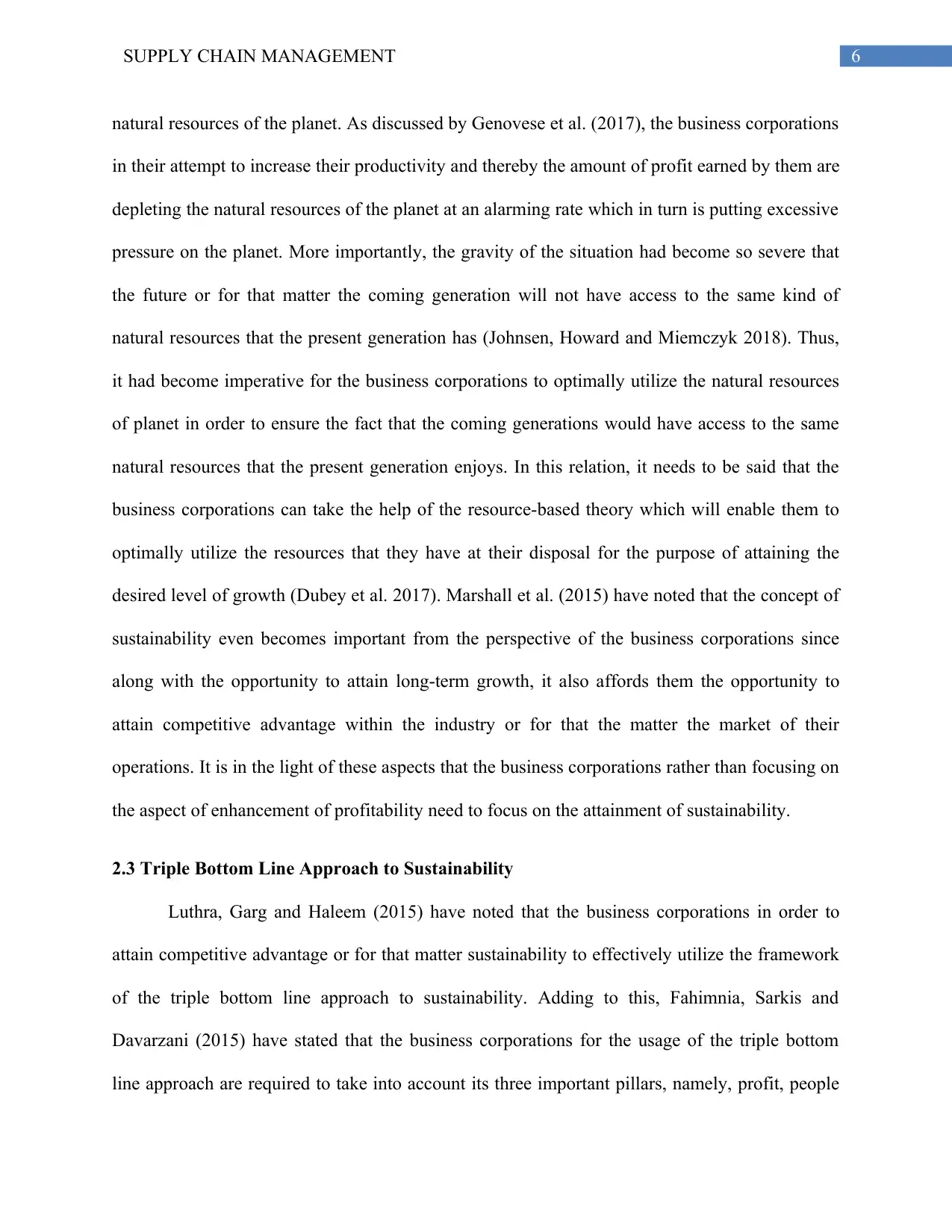
6SUPPLY CHAIN MANAGEMENT
natural resources of the planet. As discussed by Genovese et al. (2017), the business corporations
in their attempt to increase their productivity and thereby the amount of profit earned by them are
depleting the natural resources of the planet at an alarming rate which in turn is putting excessive
pressure on the planet. More importantly, the gravity of the situation had become so severe that
the future or for that matter the coming generation will not have access to the same kind of
natural resources that the present generation has (Johnsen, Howard and Miemczyk 2018). Thus,
it had become imperative for the business corporations to optimally utilize the natural resources
of planet in order to ensure the fact that the coming generations would have access to the same
natural resources that the present generation enjoys. In this relation, it needs to be said that the
business corporations can take the help of the resource-based theory which will enable them to
optimally utilize the resources that they have at their disposal for the purpose of attaining the
desired level of growth (Dubey et al. 2017). Marshall et al. (2015) have noted that the concept of
sustainability even becomes important from the perspective of the business corporations since
along with the opportunity to attain long-term growth, it also affords them the opportunity to
attain competitive advantage within the industry or for that the matter the market of their
operations. It is in the light of these aspects that the business corporations rather than focusing on
the aspect of enhancement of profitability need to focus on the attainment of sustainability.
2.3 Triple Bottom Line Approach to Sustainability
Luthra, Garg and Haleem (2015) have noted that the business corporations in order to
attain competitive advantage or for that matter sustainability to effectively utilize the framework
of the triple bottom line approach to sustainability. Adding to this, Fahimnia, Sarkis and
Davarzani (2015) have stated that the business corporations for the usage of the triple bottom
line approach are required to take into account its three important pillars, namely, profit, people
natural resources of the planet. As discussed by Genovese et al. (2017), the business corporations
in their attempt to increase their productivity and thereby the amount of profit earned by them are
depleting the natural resources of the planet at an alarming rate which in turn is putting excessive
pressure on the planet. More importantly, the gravity of the situation had become so severe that
the future or for that matter the coming generation will not have access to the same kind of
natural resources that the present generation has (Johnsen, Howard and Miemczyk 2018). Thus,
it had become imperative for the business corporations to optimally utilize the natural resources
of planet in order to ensure the fact that the coming generations would have access to the same
natural resources that the present generation enjoys. In this relation, it needs to be said that the
business corporations can take the help of the resource-based theory which will enable them to
optimally utilize the resources that they have at their disposal for the purpose of attaining the
desired level of growth (Dubey et al. 2017). Marshall et al. (2015) have noted that the concept of
sustainability even becomes important from the perspective of the business corporations since
along with the opportunity to attain long-term growth, it also affords them the opportunity to
attain competitive advantage within the industry or for that the matter the market of their
operations. It is in the light of these aspects that the business corporations rather than focusing on
the aspect of enhancement of profitability need to focus on the attainment of sustainability.
2.3 Triple Bottom Line Approach to Sustainability
Luthra, Garg and Haleem (2015) have noted that the business corporations in order to
attain competitive advantage or for that matter sustainability to effectively utilize the framework
of the triple bottom line approach to sustainability. Adding to this, Fahimnia, Sarkis and
Davarzani (2015) have stated that the business corporations for the usage of the triple bottom
line approach are required to take into account its three important pillars, namely, profit, people
Paraphrase This Document
Need a fresh take? Get an instant paraphrase of this document with our AI Paraphraser
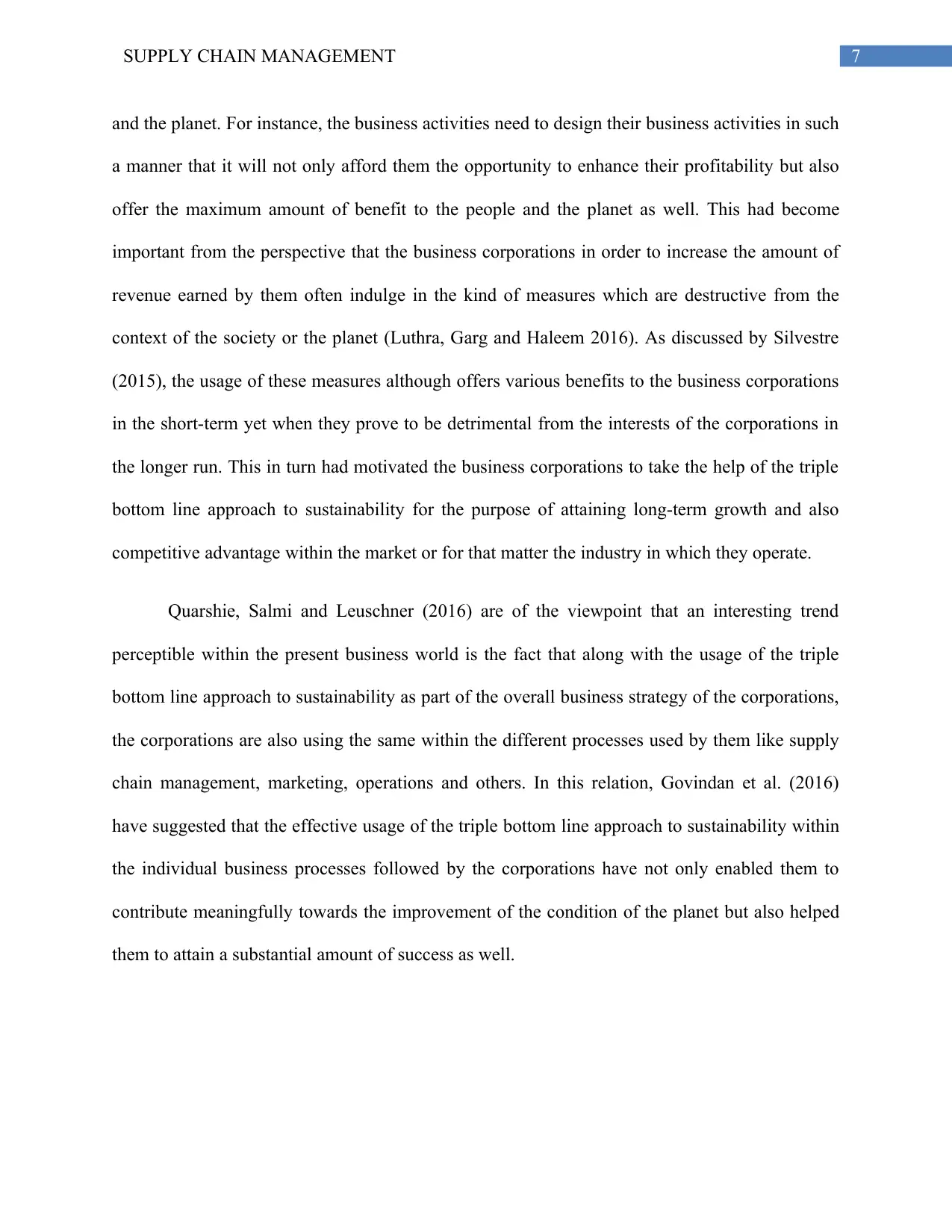
7SUPPLY CHAIN MANAGEMENT
and the planet. For instance, the business activities need to design their business activities in such
a manner that it will not only afford them the opportunity to enhance their profitability but also
offer the maximum amount of benefit to the people and the planet as well. This had become
important from the perspective that the business corporations in order to increase the amount of
revenue earned by them often indulge in the kind of measures which are destructive from the
context of the society or the planet (Luthra, Garg and Haleem 2016). As discussed by Silvestre
(2015), the usage of these measures although offers various benefits to the business corporations
in the short-term yet when they prove to be detrimental from the interests of the corporations in
the longer run. This in turn had motivated the business corporations to take the help of the triple
bottom line approach to sustainability for the purpose of attaining long-term growth and also
competitive advantage within the market or for that matter the industry in which they operate.
Quarshie, Salmi and Leuschner (2016) are of the viewpoint that an interesting trend
perceptible within the present business world is the fact that along with the usage of the triple
bottom line approach to sustainability as part of the overall business strategy of the corporations,
the corporations are also using the same within the different processes used by them like supply
chain management, marketing, operations and others. In this relation, Govindan et al. (2016)
have suggested that the effective usage of the triple bottom line approach to sustainability within
the individual business processes followed by the corporations have not only enabled them to
contribute meaningfully towards the improvement of the condition of the planet but also helped
them to attain a substantial amount of success as well.
and the planet. For instance, the business activities need to design their business activities in such
a manner that it will not only afford them the opportunity to enhance their profitability but also
offer the maximum amount of benefit to the people and the planet as well. This had become
important from the perspective that the business corporations in order to increase the amount of
revenue earned by them often indulge in the kind of measures which are destructive from the
context of the society or the planet (Luthra, Garg and Haleem 2016). As discussed by Silvestre
(2015), the usage of these measures although offers various benefits to the business corporations
in the short-term yet when they prove to be detrimental from the interests of the corporations in
the longer run. This in turn had motivated the business corporations to take the help of the triple
bottom line approach to sustainability for the purpose of attaining long-term growth and also
competitive advantage within the market or for that matter the industry in which they operate.
Quarshie, Salmi and Leuschner (2016) are of the viewpoint that an interesting trend
perceptible within the present business world is the fact that along with the usage of the triple
bottom line approach to sustainability as part of the overall business strategy of the corporations,
the corporations are also using the same within the different processes used by them like supply
chain management, marketing, operations and others. In this relation, Govindan et al. (2016)
have suggested that the effective usage of the triple bottom line approach to sustainability within
the individual business processes followed by the corporations have not only enabled them to
contribute meaningfully towards the improvement of the condition of the planet but also helped
them to attain a substantial amount of success as well.
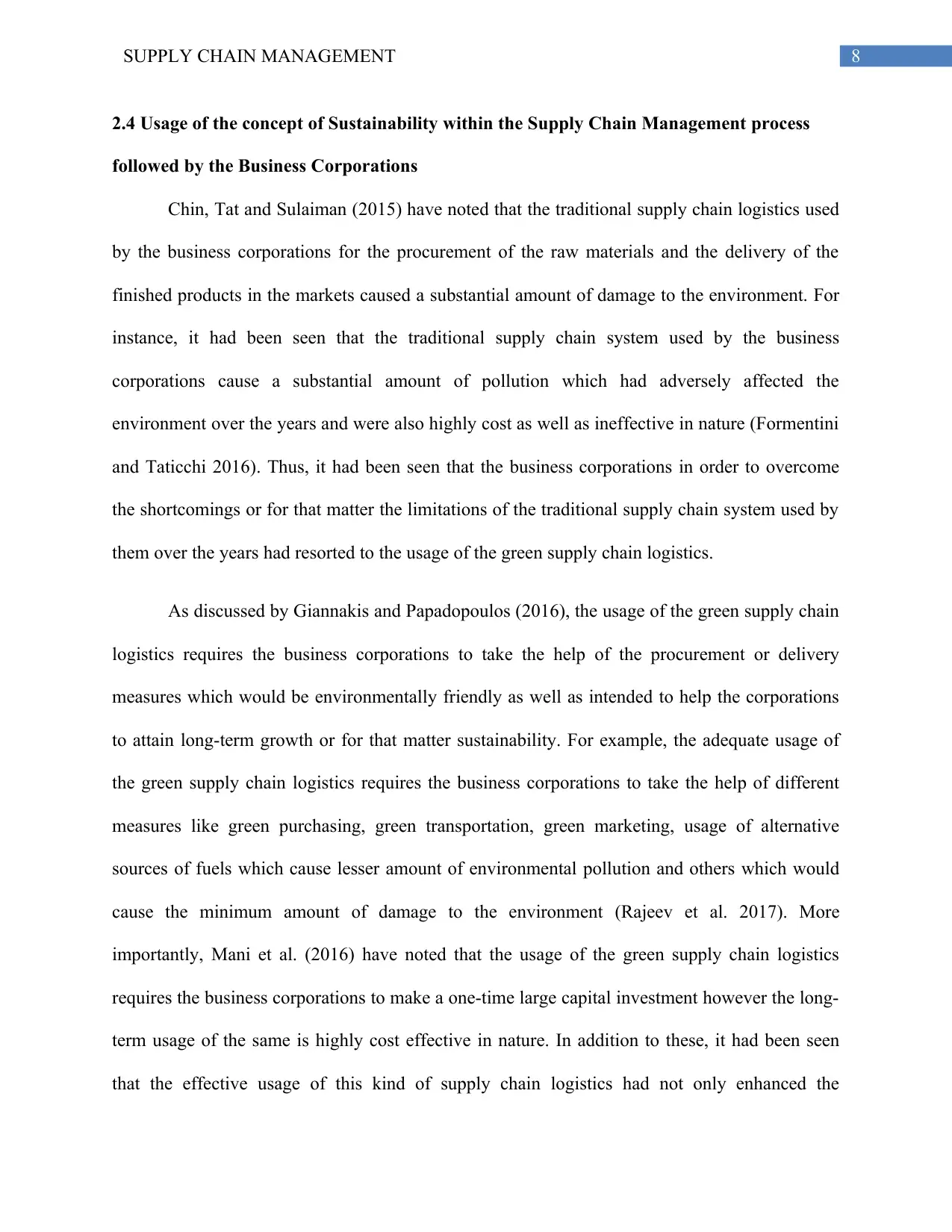
8SUPPLY CHAIN MANAGEMENT
2.4 Usage of the concept of Sustainability within the Supply Chain Management process
followed by the Business Corporations
Chin, Tat and Sulaiman (2015) have noted that the traditional supply chain logistics used
by the business corporations for the procurement of the raw materials and the delivery of the
finished products in the markets caused a substantial amount of damage to the environment. For
instance, it had been seen that the traditional supply chain system used by the business
corporations cause a substantial amount of pollution which had adversely affected the
environment over the years and were also highly cost as well as ineffective in nature (Formentini
and Taticchi 2016). Thus, it had been seen that the business corporations in order to overcome
the shortcomings or for that matter the limitations of the traditional supply chain system used by
them over the years had resorted to the usage of the green supply chain logistics.
As discussed by Giannakis and Papadopoulos (2016), the usage of the green supply chain
logistics requires the business corporations to take the help of the procurement or delivery
measures which would be environmentally friendly as well as intended to help the corporations
to attain long-term growth or for that matter sustainability. For example, the adequate usage of
the green supply chain logistics requires the business corporations to take the help of different
measures like green purchasing, green transportation, green marketing, usage of alternative
sources of fuels which cause lesser amount of environmental pollution and others which would
cause the minimum amount of damage to the environment (Rajeev et al. 2017). More
importantly, Mani et al. (2016) have noted that the usage of the green supply chain logistics
requires the business corporations to make a one-time large capital investment however the long-
term usage of the same is highly cost effective in nature. In addition to these, it had been seen
that the effective usage of this kind of supply chain logistics had not only enhanced the
2.4 Usage of the concept of Sustainability within the Supply Chain Management process
followed by the Business Corporations
Chin, Tat and Sulaiman (2015) have noted that the traditional supply chain logistics used
by the business corporations for the procurement of the raw materials and the delivery of the
finished products in the markets caused a substantial amount of damage to the environment. For
instance, it had been seen that the traditional supply chain system used by the business
corporations cause a substantial amount of pollution which had adversely affected the
environment over the years and were also highly cost as well as ineffective in nature (Formentini
and Taticchi 2016). Thus, it had been seen that the business corporations in order to overcome
the shortcomings or for that matter the limitations of the traditional supply chain system used by
them over the years had resorted to the usage of the green supply chain logistics.
As discussed by Giannakis and Papadopoulos (2016), the usage of the green supply chain
logistics requires the business corporations to take the help of the procurement or delivery
measures which would be environmentally friendly as well as intended to help the corporations
to attain long-term growth or for that matter sustainability. For example, the adequate usage of
the green supply chain logistics requires the business corporations to take the help of different
measures like green purchasing, green transportation, green marketing, usage of alternative
sources of fuels which cause lesser amount of environmental pollution and others which would
cause the minimum amount of damage to the environment (Rajeev et al. 2017). More
importantly, Mani et al. (2016) have noted that the usage of the green supply chain logistics
requires the business corporations to make a one-time large capital investment however the long-
term usage of the same is highly cost effective in nature. In addition to these, it had been seen
that the effective usage of this kind of supply chain logistics had not only enhanced the
⊘ This is a preview!⊘
Do you want full access?
Subscribe today to unlock all pages.

Trusted by 1+ million students worldwide
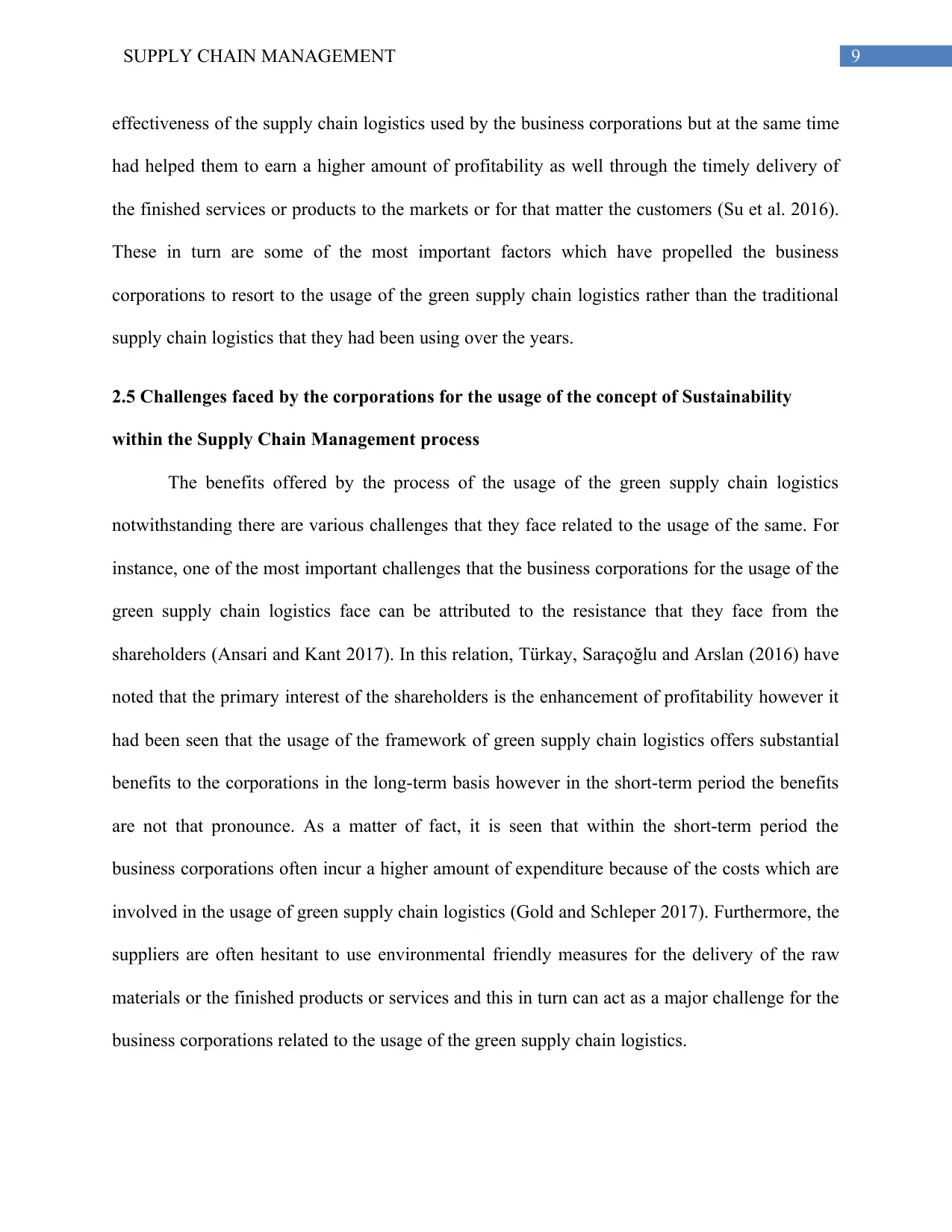
9SUPPLY CHAIN MANAGEMENT
effectiveness of the supply chain logistics used by the business corporations but at the same time
had helped them to earn a higher amount of profitability as well through the timely delivery of
the finished services or products to the markets or for that matter the customers (Su et al. 2016).
These in turn are some of the most important factors which have propelled the business
corporations to resort to the usage of the green supply chain logistics rather than the traditional
supply chain logistics that they had been using over the years.
2.5 Challenges faced by the corporations for the usage of the concept of Sustainability
within the Supply Chain Management process
The benefits offered by the process of the usage of the green supply chain logistics
notwithstanding there are various challenges that they face related to the usage of the same. For
instance, one of the most important challenges that the business corporations for the usage of the
green supply chain logistics face can be attributed to the resistance that they face from the
shareholders (Ansari and Kant 2017). In this relation, Türkay, Saraçoğlu and Arslan (2016) have
noted that the primary interest of the shareholders is the enhancement of profitability however it
had been seen that the usage of the framework of green supply chain logistics offers substantial
benefits to the corporations in the long-term basis however in the short-term period the benefits
are not that pronounce. As a matter of fact, it is seen that within the short-term period the
business corporations often incur a higher amount of expenditure because of the costs which are
involved in the usage of green supply chain logistics (Gold and Schleper 2017). Furthermore, the
suppliers are often hesitant to use environmental friendly measures for the delivery of the raw
materials or the finished products or services and this in turn can act as a major challenge for the
business corporations related to the usage of the green supply chain logistics.
effectiveness of the supply chain logistics used by the business corporations but at the same time
had helped them to earn a higher amount of profitability as well through the timely delivery of
the finished services or products to the markets or for that matter the customers (Su et al. 2016).
These in turn are some of the most important factors which have propelled the business
corporations to resort to the usage of the green supply chain logistics rather than the traditional
supply chain logistics that they had been using over the years.
2.5 Challenges faced by the corporations for the usage of the concept of Sustainability
within the Supply Chain Management process
The benefits offered by the process of the usage of the green supply chain logistics
notwithstanding there are various challenges that they face related to the usage of the same. For
instance, one of the most important challenges that the business corporations for the usage of the
green supply chain logistics face can be attributed to the resistance that they face from the
shareholders (Ansari and Kant 2017). In this relation, Türkay, Saraçoğlu and Arslan (2016) have
noted that the primary interest of the shareholders is the enhancement of profitability however it
had been seen that the usage of the framework of green supply chain logistics offers substantial
benefits to the corporations in the long-term basis however in the short-term period the benefits
are not that pronounce. As a matter of fact, it is seen that within the short-term period the
business corporations often incur a higher amount of expenditure because of the costs which are
involved in the usage of green supply chain logistics (Gold and Schleper 2017). Furthermore, the
suppliers are often hesitant to use environmental friendly measures for the delivery of the raw
materials or the finished products or services and this in turn can act as a major challenge for the
business corporations related to the usage of the green supply chain logistics.
Paraphrase This Document
Need a fresh take? Get an instant paraphrase of this document with our AI Paraphraser
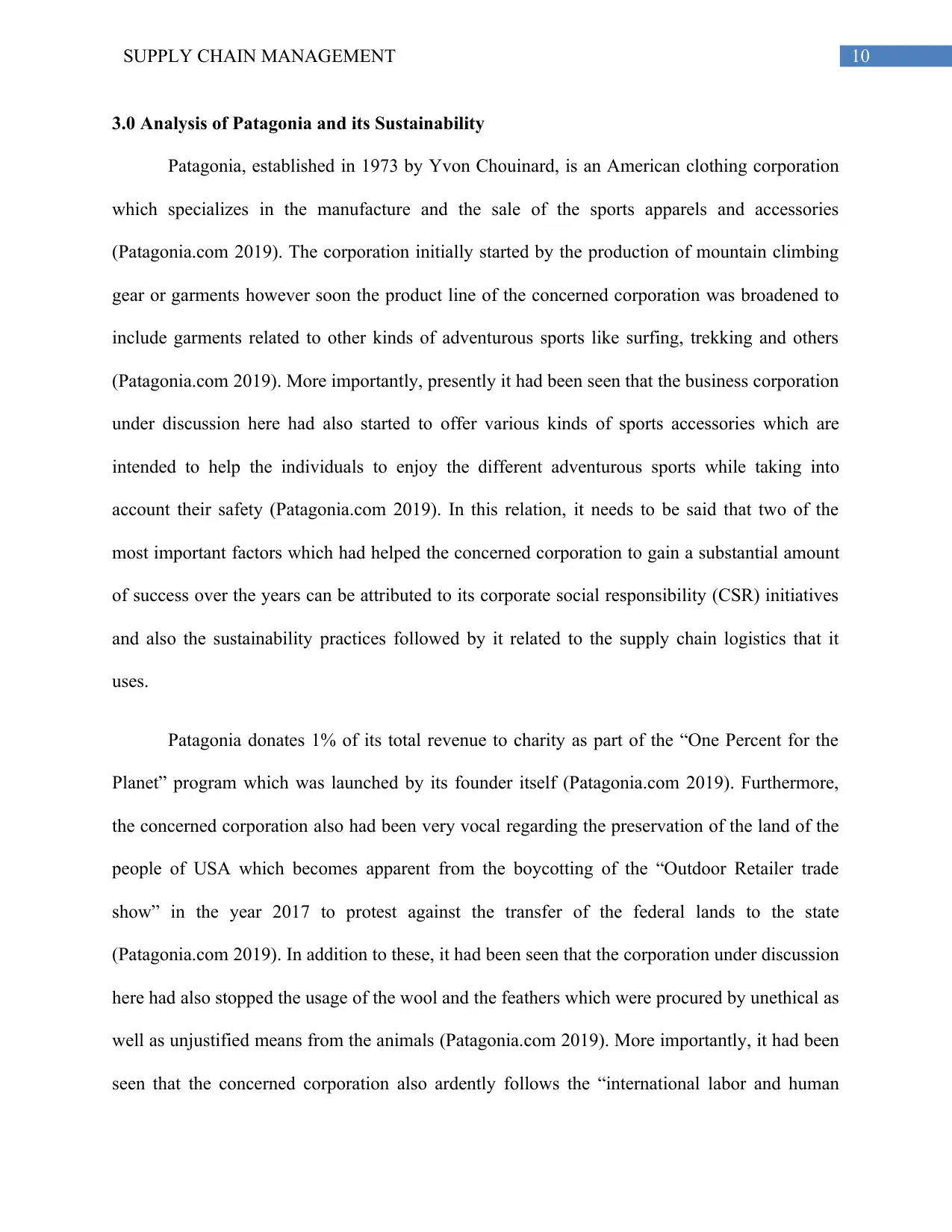
10SUPPLY CHAIN MANAGEMENT
3.0 Analysis of Patagonia and its Sustainability
Patagonia, established in 1973 by Yvon Chouinard, is an American clothing corporation
which specializes in the manufacture and the sale of the sports apparels and accessories
(Patagonia.com 2019). The corporation initially started by the production of mountain climbing
gear or garments however soon the product line of the concerned corporation was broadened to
include garments related to other kinds of adventurous sports like surfing, trekking and others
(Patagonia.com 2019). More importantly, presently it had been seen that the business corporation
under discussion here had also started to offer various kinds of sports accessories which are
intended to help the individuals to enjoy the different adventurous sports while taking into
account their safety (Patagonia.com 2019). In this relation, it needs to be said that two of the
most important factors which had helped the concerned corporation to gain a substantial amount
of success over the years can be attributed to its corporate social responsibility (CSR) initiatives
and also the sustainability practices followed by it related to the supply chain logistics that it
uses.
Patagonia donates 1% of its total revenue to charity as part of the “One Percent for the
Planet” program which was launched by its founder itself (Patagonia.com 2019). Furthermore,
the concerned corporation also had been very vocal regarding the preservation of the land of the
people of USA which becomes apparent from the boycotting of the “Outdoor Retailer trade
show” in the year 2017 to protest against the transfer of the federal lands to the state
(Patagonia.com 2019). In addition to these, it had been seen that the corporation under discussion
here had also stopped the usage of the wool and the feathers which were procured by unethical as
well as unjustified means from the animals (Patagonia.com 2019). More importantly, it had been
seen that the concerned corporation also ardently follows the “international labor and human
3.0 Analysis of Patagonia and its Sustainability
Patagonia, established in 1973 by Yvon Chouinard, is an American clothing corporation
which specializes in the manufacture and the sale of the sports apparels and accessories
(Patagonia.com 2019). The corporation initially started by the production of mountain climbing
gear or garments however soon the product line of the concerned corporation was broadened to
include garments related to other kinds of adventurous sports like surfing, trekking and others
(Patagonia.com 2019). More importantly, presently it had been seen that the business corporation
under discussion here had also started to offer various kinds of sports accessories which are
intended to help the individuals to enjoy the different adventurous sports while taking into
account their safety (Patagonia.com 2019). In this relation, it needs to be said that two of the
most important factors which had helped the concerned corporation to gain a substantial amount
of success over the years can be attributed to its corporate social responsibility (CSR) initiatives
and also the sustainability practices followed by it related to the supply chain logistics that it
uses.
Patagonia donates 1% of its total revenue to charity as part of the “One Percent for the
Planet” program which was launched by its founder itself (Patagonia.com 2019). Furthermore,
the concerned corporation also had been very vocal regarding the preservation of the land of the
people of USA which becomes apparent from the boycotting of the “Outdoor Retailer trade
show” in the year 2017 to protest against the transfer of the federal lands to the state
(Patagonia.com 2019). In addition to these, it had been seen that the corporation under discussion
here had also stopped the usage of the wool and the feathers which were procured by unethical as
well as unjustified means from the animals (Patagonia.com 2019). More importantly, it had been
seen that the concerned corporation also ardently follows the “international labor and human
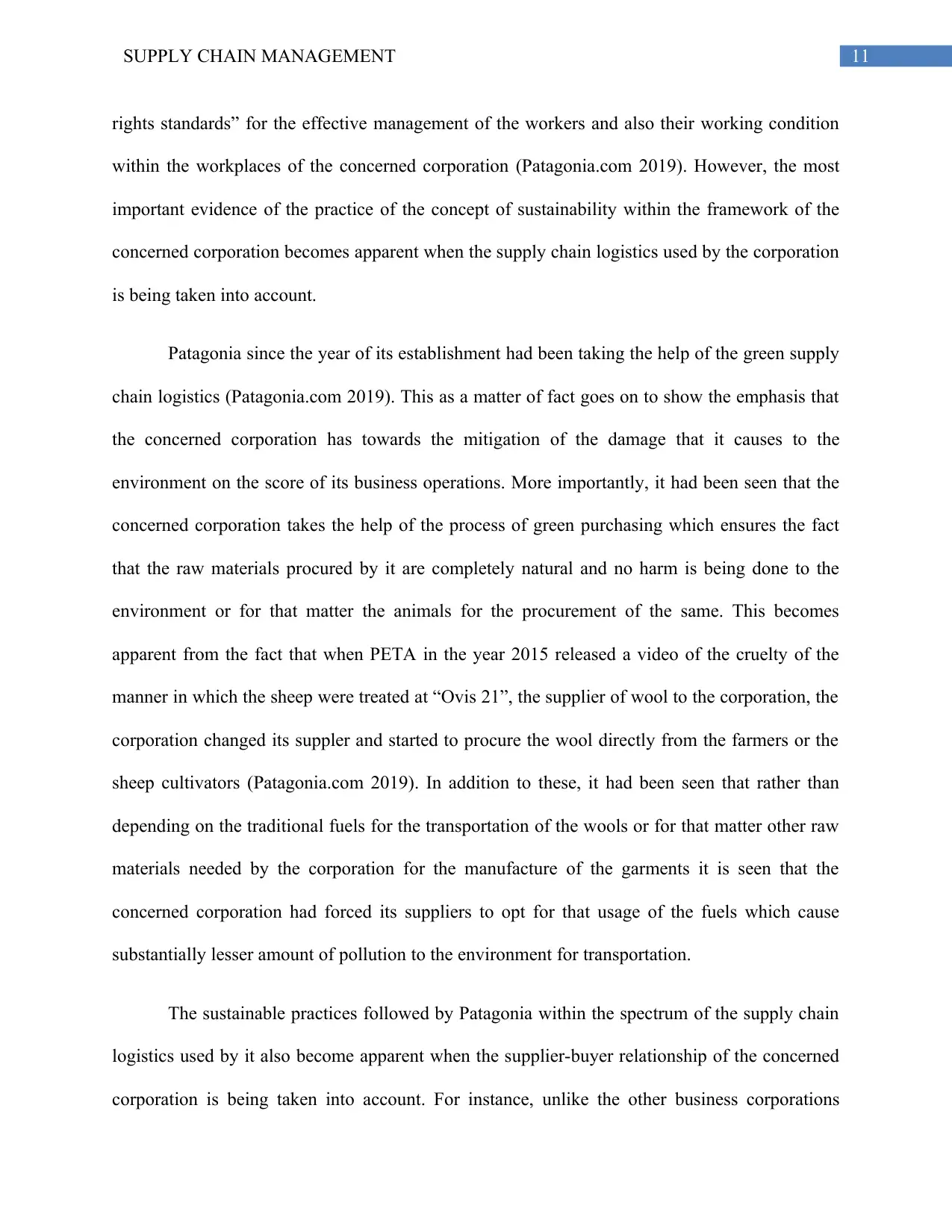
11SUPPLY CHAIN MANAGEMENT
rights standards” for the effective management of the workers and also their working condition
within the workplaces of the concerned corporation (Patagonia.com 2019). However, the most
important evidence of the practice of the concept of sustainability within the framework of the
concerned corporation becomes apparent when the supply chain logistics used by the corporation
is being taken into account.
Patagonia since the year of its establishment had been taking the help of the green supply
chain logistics (Patagonia.com 2019). This as a matter of fact goes on to show the emphasis that
the concerned corporation has towards the mitigation of the damage that it causes to the
environment on the score of its business operations. More importantly, it had been seen that the
concerned corporation takes the help of the process of green purchasing which ensures the fact
that the raw materials procured by it are completely natural and no harm is being done to the
environment or for that matter the animals for the procurement of the same. This becomes
apparent from the fact that when PETA in the year 2015 released a video of the cruelty of the
manner in which the sheep were treated at “Ovis 21”, the supplier of wool to the corporation, the
corporation changed its suppler and started to procure the wool directly from the farmers or the
sheep cultivators (Patagonia.com 2019). In addition to these, it had been seen that rather than
depending on the traditional fuels for the transportation of the wools or for that matter other raw
materials needed by the corporation for the manufacture of the garments it is seen that the
concerned corporation had forced its suppliers to opt for that usage of the fuels which cause
substantially lesser amount of pollution to the environment for transportation.
The sustainable practices followed by Patagonia within the spectrum of the supply chain
logistics used by it also become apparent when the supplier-buyer relationship of the concerned
corporation is being taken into account. For instance, unlike the other business corporations
rights standards” for the effective management of the workers and also their working condition
within the workplaces of the concerned corporation (Patagonia.com 2019). However, the most
important evidence of the practice of the concept of sustainability within the framework of the
concerned corporation becomes apparent when the supply chain logistics used by the corporation
is being taken into account.
Patagonia since the year of its establishment had been taking the help of the green supply
chain logistics (Patagonia.com 2019). This as a matter of fact goes on to show the emphasis that
the concerned corporation has towards the mitigation of the damage that it causes to the
environment on the score of its business operations. More importantly, it had been seen that the
concerned corporation takes the help of the process of green purchasing which ensures the fact
that the raw materials procured by it are completely natural and no harm is being done to the
environment or for that matter the animals for the procurement of the same. This becomes
apparent from the fact that when PETA in the year 2015 released a video of the cruelty of the
manner in which the sheep were treated at “Ovis 21”, the supplier of wool to the corporation, the
corporation changed its suppler and started to procure the wool directly from the farmers or the
sheep cultivators (Patagonia.com 2019). In addition to these, it had been seen that rather than
depending on the traditional fuels for the transportation of the wools or for that matter other raw
materials needed by the corporation for the manufacture of the garments it is seen that the
concerned corporation had forced its suppliers to opt for that usage of the fuels which cause
substantially lesser amount of pollution to the environment for transportation.
The sustainable practices followed by Patagonia within the spectrum of the supply chain
logistics used by it also become apparent when the supplier-buyer relationship of the concerned
corporation is being taken into account. For instance, unlike the other business corporations
⊘ This is a preview!⊘
Do you want full access?
Subscribe today to unlock all pages.

Trusted by 1+ million students worldwide
1 out of 23
Related Documents
Your All-in-One AI-Powered Toolkit for Academic Success.
+13062052269
info@desklib.com
Available 24*7 on WhatsApp / Email
![[object Object]](/_next/static/media/star-bottom.7253800d.svg)
Unlock your academic potential
Copyright © 2020–2025 A2Z Services. All Rights Reserved. Developed and managed by ZUCOL.





